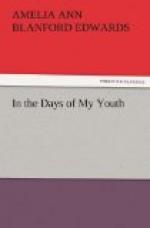* * * * *
CHAPTER XXXVII.
GUICHET THE MODEL.
To the man who lives alone and walks about with his eyes open, the mere bricks and mortar of a great city are instinct with character. Buildings become to him like living creatures. The streets tell him tales. For him, the house-fronts are written over with hieroglyphics which, to the passing crowd, are either unseen or without meaning. Fallen grandeur, pretentious gentility, decent poverty, the infamy that wears a brazen front, and the crime that burrows in darkness—he knows them all at a glance. The patched window, the dingy blind, the shattered doorstep, the pot of mignonette on the garret ledge, are to him as significant as the lines and wrinkles on a human face. He grows to like some houses and to dislike others, almost without knowing why—just as one grows to like or dislike certain faces in the parks and clubs. I remember now, as well as if it were yesterday, how, during the first weeks of my life in Paris, I fell in love at first sight with a wee maisonnette at the corner of a certain street overlooking the Luxembourg gardens—a tiny little house, with soft-looking blue silk window-curtains, and cream-colored jalousies, and boxes of red and white geraniums at all the windows. I never knew who lived in that sunny little nest; I never saw a face at any of those windows; yet I used to go out of my way in the summer evenings to look at it, as one might go to look at a beautiful woman behind a stall in the market-place, or at a Madonna in a shop-window.
At the time about which I write, there was probably no city in Europe of which the street-scenery was so interesting as that of Paris. I have already described the Quartier Latin, joyous, fantastic, out-at-elbows; a world in itself and by itself; unlike anything else in Paris or elsewhere. But there were other districts in the great city—now swept away and forgotten—as characteristic in their way as the Quartier Latin. There was the He de Saint Louis, for instance—a Campo Santo of decayed nobility—lonely, silent, fallen upon evil days, and haunted here and there by ghosts of departed Marquises and Abbes of the vieille ecole. There was the debateable land to the rear of the Invalides and the Champ de Mars. There was the Faubourg St. Germain, fast falling into the sere and yellow leaf, and going the way of the Ile de Saint Louis. There was the neighborhood of the Boulevart d’Aulnay, and the Rue de la Roquette, ghastly with the trades of death; a whole Quartier of monumental sculptors, makers of iron crosses, weavers of funereal chaplets, and wholesale coffin-factors. And beside and apart from all this, there were (as in all great cities) districts of evil report and obscure topography—lost islets of crime, round which flowed and circled the daily tide of Paris life; flowed and circled, yet never penetrated. A dark arch here and there—the mouth of a foul alley—a riverside vista of gloom and squalor, marked the entrance to these Alsatias. Such an Alsatia was the Rue Pierre Lescot, the Rue Sans Nom, and many more than I can now remember—streets into which no sane man would venture after nightfall without the escort of the police.




